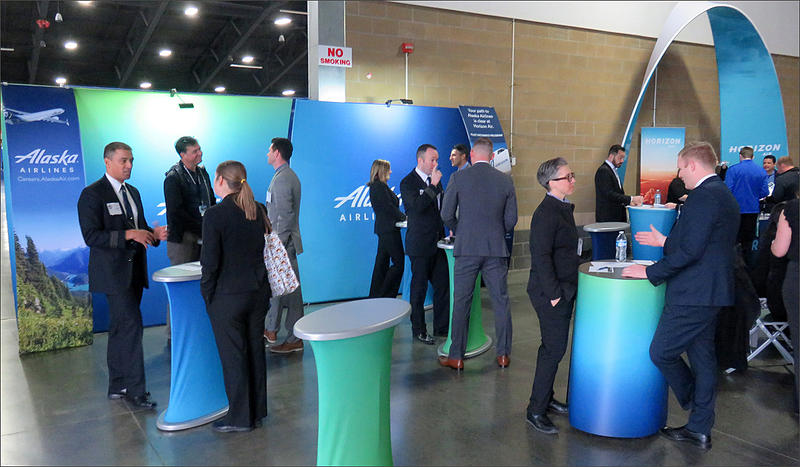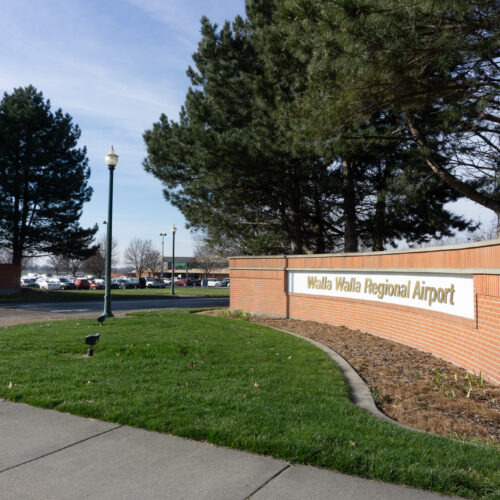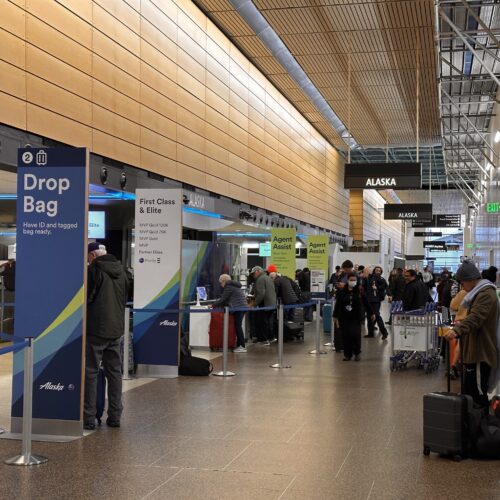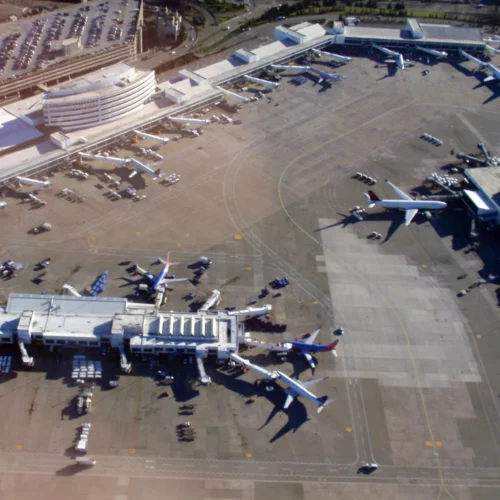
Airlines Recruiting Like Crazy To Address Pilot Shortage
Listen
Last year, Horizon Air was forced to cut back the number of flights to many (Pacific) Northwest cities because it didn’t have enough pilots. The Alaska Air Group subsidiary has stabilized its ranks and is slowly rebuilding service.
But an industrywide pilot shortage continues. And the airlines are hungry—as hungry as the organizers of the Northwest Aviation Trade Show have ever seen.
Recruiters from nearly a dozen regional airlines have come here to meet aspiring pilots and students at a career forum on the eve of the annual convention. Information tables for airlines, flight schools and industry groups line the perimeter of a cavernous fairgrounds hall. You could even get an on-the-spot initial interview.
Minnesota-based Compass Airlines sent recruiter Emmie Nguyen. She said the airline which operates as Delta Connection or American Eagle is looking to hire 400 new pilots this year.
“My personal goal is as many as we can get—minimum at 400,” Nguyen said. “Our attrition is very high as well. So we lose about 20 to 30 to 35, sometimes 40, pilots to major airlines each month.”
That’s because the major airlines are experiencing a wave of retirements. They backfill by plucking pilots from regional carriers.
Other factors in play here: The whole sector is growing. Then there’s the tough work schedules pilots endure and extensive training requirements.
Nguyen said the regional airlines have increased what used to be low starting pay for pilots by “quite a bit,” because of competition. Now come signing and retention bonuses.
“Right now, we have a $17,500 signing bonus,” Nguyen said. “You’re looking at me like you’re shocked. But you’d be surprised. There are so many other regional airlines out there who are offering way more than we do.”
Seattle-based Horizon Air and its big sister Alaska Airlines had a huge recruiting presence at the career fair in Puyallup in late February. Vice President for Flight Operations John Hornibrook said Horizon alone wants to hire more than 300 pilots this year. The regional carrier’s flight schedule was hit hard by a pilot shortage last year.
“Right now, we’re almost back to where we’re supposed to be,” Hornibrook said. “We’ve really righted the ship. We were able to right the ship pretty fast.”
Hornibrook said he’s never seen the industry look like this in his 30 years. He’s now working on building a long-term pilot pipeline with flight schools to feed his company.
U.S. Army chopper pilot Matt Moss is giving Horizon a good look along with several of its competitors. Moss realizes he’s leaving the service at a good time. Still, he said he was taken aback by the starting pay.
“For me it will be a pay cut to go to the regionals—about half of what I make right now in the military,” Moss said. “It’s going to be hard those first couple of years to get through that. I really probably don’t have any room to complain because this pay has been adjusted way up because of this situation compared to what it was just a couple years ago.”
Eighteen-year-old high school senior Chase Van Dyk of Enumclaw, Washington, is also excited to contemplate a pilot career. His first choice is to enroll for an aviation degree and airline pilot training at Central Washington University. It’s one of the cheaper options in the Northwest but still pricey for this.
Van Dyk faces a total cost including many hours of flight time around $100,000. Out of state, the beginning to end cost could be as much as $150,000.
But remember how hungry those airlines are? Van Dyk noticed they’re now reimbursing partial tuition or giving stipends to promising students who commit to flying for that airline after earning their wings.
“A big company like Alaska (Airlines), for example, that’s the one I would like to work with,” he said. “I would love to work with them. If they would pay for me to go to school I would just love that. It would be just a great help.”
Public and private flight schools are expanding enrollment capacity. But what goes around comes around. Some of them are having trouble holding on to faculty, instructors and mechanics given the competitive labor market.
“The airlines are almost eating their young, because if you take away all the industry trainers you’re not going to have anybody to train the next group of people coming through,” observed CWU Department of Aviation Director of Flight Operations Andy McIrvin.
“It’s a good time to be a pilot right now because you don’t have to hunt for a job,” McIrvin continued. “The airlines are coming to you, throwing money at you, asking you if you want to work for them.”
McIrvin said some regional airlines are paying advanced aviation students to recruit for them on campus or paying “finder’s fees.”
Washington state Rep. Tom Dent, who is a pilot, introduced a bill last week to create a state scholarship and college loan program for students who aspire to become commercial pilots. He said the intent is to increase the supply of pilots in Washington to meet industry demand.
According to the bill text, the scholarship fund would be seeded with private and corporate donations and state matching money.
The measure was introduced too late in the short 2018 legislative session to receive serious consideration. Dent said he will reintroduce the bill next year.
Copyright 2018 Northwest News Network
Related Stories:

How Washington’s small airports are getting their flights back
The Walla Walla Regional Airport once again has two daily roundtrip flights that connect it to Seattle. (Credit: Susan Shain / NWPB) Listen (Runtime :59) Read During the pandemic, Alaska

A Journey Delayed — Sea-Tac airport flights delayed, canceled after 737 MAX 9 grounding
The ticketing counter, bag drop, and agent stations for Alaska Airlines at Sea-Tac International Airport were busy but not crowded late Tuesday morning. Some passengers moved through the lines and onto security, others stood against the wall opposite Alaska’s blue and green signs, with their bags sitting closely next to them, scrolling through phones, waiting for a journey, delayed.
On Tuesday, FlightAware reported over 60 cancellations and over 140 delays at the airport, the majority of which were Alaska Airlines flights.

WA airport search committee disbands without site recommendation after turbulent process
A Washington committee studying options for a new regional airport location met for the final time Friday, and will disband at the end of this month without recommending a single site to the Legislature.















